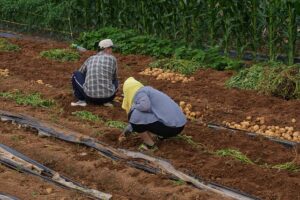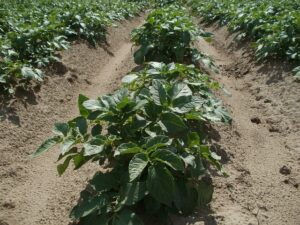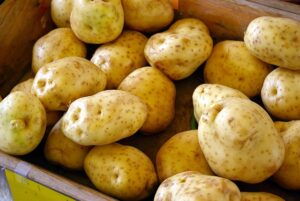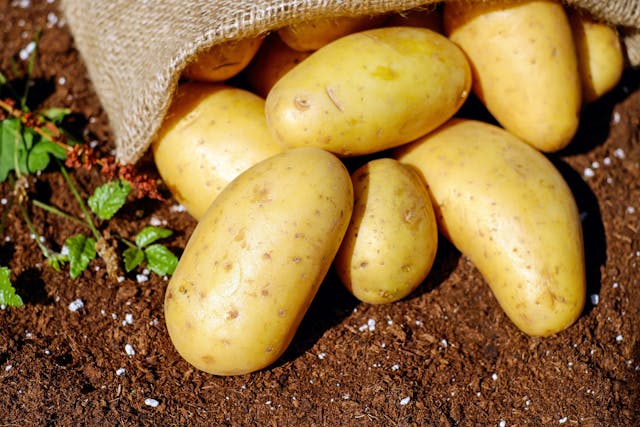Potatoes, a versatile and beloved staple in many cuisines, are surprisingly easy to grow in your own backyard. Whether you have a spacious garden or just a small balcony, you can cultivate potatoes and enjoy the satisfaction of harvesting your homegrown produce. In this comprehensive guide, we’ll walk you through the step-by-step process of growing potatoes, from selecting the right varieties to harvesting and storing your crop.
Selecting Potato Varieties:
Before you begin planting, it’s essential to choose the right potato varieties for your growing conditions and culinary preferences. Potatoes come in various types, including russet, red, white, and fingerling. Consider factors such as your climate, available space, and desired harvest time when selecting varieties. Early-season varieties mature faster and are ideal for gardeners in regions with short growing seasons, while late-season varieties are better suited for longer growing periods.

guide to growing potatoes
Preparing the Soil:
Potatoes thrive in loose, well-draining soil with a pH level between 5.0 and 7.0. Begin by preparing the soil in your chosen planting area by loosening it to a depth of 8 to 10 inches using a garden fork or tiller. Remove any weeds, rocks, or debris from the soil, as they can impede potato growth.
Planting Potatoes:
Potatoes can be grown from seed potatoes, which are small tubers specifically produced for planting. Avoid using potatoes from the grocery store, as they may have been treated with sprout inhibitors. Before planting, cut the seed potatoes into pieces, making sure each piece contains at least one or two eyes (sprouts). Allow the cut pieces to dry for a day to form a protective layer, which helps prevent rotting.
Plant the seed potato pieces in rows or hills, spacing them 12 to 15 inches apart with the eyes facing upward. Cover the seed potatoes with 3 to 4 inches of soil, leaving room for hilling (adding more soil later as the plants grow). Water the newly planted potatoes thoroughly to settle the soil and initiate growth.

Caring for Potato Plants:
Potatoes require consistent moisture throughout the growing season, particularly during the critical stages of tuber formation. Keep the soil evenly moist but not waterlogged to prevent rotting and encourage healthy growth. Applying a layer of organic mulch, such as straw or shredded leaves, around the plants can help retain moisture and suppress weeds.
As the potato plants grow, they will produce foliage above ground and tubers below ground. To encourage robust tuber development, “hill” the soil around the base of the plants when the foliage reaches 6 to 8 inches tall. Use a hoe or shovel to mound soil around the stems, leaving a few inches of foliage exposed. Continue hilling the soil periodically throughout the growing season to cover any exposed tubers and prevent them from turning green.

Pest and Disease Management:
Potatoes are susceptible to various pests and diseases, including potato beetles, aphids, and fungal infections like late blight. Monitor your potato plants regularly for signs of damage or infestation, such as chewed leaves, yellowing foliage, or mouldy growth. Handpick pests when possible and use organic pest control methods, such as insecticidal soap or neem oil, to manage infestations.
To prevent the spread of diseases, practice crop rotation by avoiding planting potatoes in the same location for consecutive years. Rotate potatoes with other crops, such as legumes or brassicas, to break the disease cycle and maintain soil health.
Harvesting and Storing Potatoes:
Potatoes are typically ready for harvest 70 to 120 days after planting, depending on the variety and growing conditions. Harvest new potatoes for immediate consumption when the plants begin to flower, or wait until the foliage turns yellow and dies back for mature potatoes.
To harvest potatoes, use a garden fork or shovel to carefully loosen the soil around the base of the plants, being careful not to damage the tubers. Gently lift the potatoes from the soil, taking care to avoid bruising or cutting them. Brush off any excess soil and allow the potatoes to dry in the sun for a few hours to toughen the skin.
After harvesting, store potatoes in a cool, dark place with good ventilation, such as a basement or pantry. Avoid storing potatoes near onions or other ethylene-producing fruits and vegetables, as they can cause premature sprouting. Check stored potatoes regularly for signs of sprouting, rot, or damage, and discard any affected tubers to prevent spoilage.
Conclusion:
Growing potatoes at home is a rewarding and enjoyable experience that allows you to savor the freshness and flavor of your own harvest. By following these simple steps and tips, you can successfully cultivate potatoes in your garden or containers, regardless of your level of gardening experience. So roll up your sleeves, get your hands dirty, and start growing your own delicious potatoes today!

